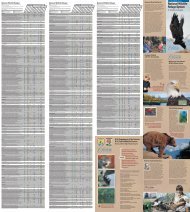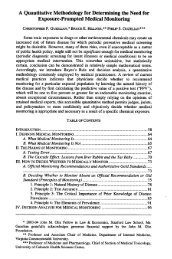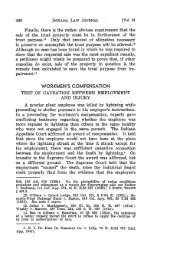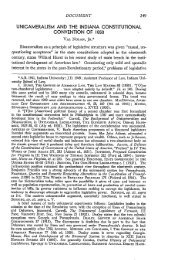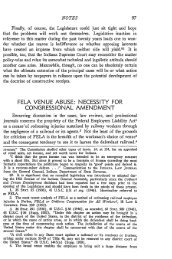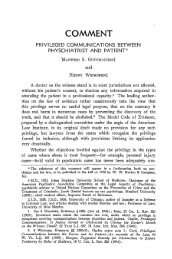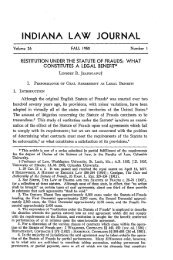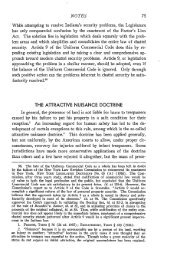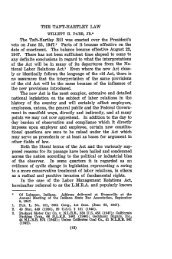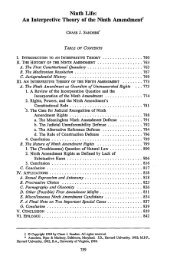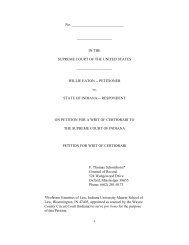Bridgeport Music v. Dimension Films - Indiana University School of ...
Bridgeport Music v. Dimension Films - Indiana University School of ...
Bridgeport Music v. Dimension Films - Indiana University School of ...
Create successful ePaper yourself
Turn your PDF publications into a flip-book with our unique Google optimized e-Paper software.
456 INDIANA LAW JOURNAL [Vol. 81:435<br />
legislative history to justify treating sound recordings differently from other subject<br />
matter with regard to the pro<strong>of</strong> required for infringement. 164<br />
The <strong>Bridgeport</strong> court claimed that its decision was motivated in part by judicial<br />
economy, 165 but the rule it announced would not advance this goal. First, it seems that<br />
the <strong>Bridgeport</strong> court’s decision will have precisely the opposite effect that it intends—<br />
by holding that everyone who samples as little as a single note is infringing, the court<br />
opens the floodgates to more lawsuits. Second, despite its intentions, the court did not<br />
actually eliminate the de minimis doctrine with respect to sound recordings. An<br />
analysis similar to de minimis is used in considering the affirmative defense <strong>of</strong> fair<br />
use. 166 However, fair use cases involve a complex, fact-specific analysis that is almost<br />
never amenable to summary judgment; de minimis cases, in contrast, can be (and <strong>of</strong>ten<br />
are) decided on a motion for summary judgment. 167 Thus, the <strong>Bridgeport</strong> court’s rule<br />
will increase not only the number <strong>of</strong> copyright infringement suits, but also the<br />
complexity <strong>of</strong> those suits.<br />
The court states that its primary economic concerns are those <strong>of</strong> the music industry<br />
and claims that its rule will protect artists’ works by ensuring that others cannot steal<br />
pieces from that work and capitalize on it. 168 However, the court’s rule would impose<br />
unacceptable costs on the music industry as well. First, the transaction costs would be<br />
extremely high. Producers and record studios would have to spend more time and<br />
money obtaining sample clearances, and thus they would be less likely to produce<br />
albums with multiple sample-based tracks. Additionally, sample clearance fees would<br />
increase because artists would have no option but to obtain a license or not use the<br />
sample. 169 The court seems to think that the price <strong>of</strong> licenses will not be an issue<br />
because the markets will control the prices. However, a copyright is, by definition, a<br />
monopoly. There is a market for sample licenses now that is able to operate relatively<br />
freely. If, under the <strong>Bridgeport</strong> rule, everyone is required to buy a license for every<br />
note they sample, it takes away freedom <strong>of</strong> choice. Sound recording owners (consisting<br />
mostly <strong>of</strong> studios) can charge whatever they want because, with a captive market, the<br />
buyer only has one choice—take it or leave it. 170 This is not the kind <strong>of</strong> “limited<br />
monopoly” the Framers had in mind.<br />
Another justification the court presents for its rule is that the rule is easily<br />
enforceable. However, if infringement starts with just one note, it seems that the rule<br />
would be more difficult to enforce. First, as previously discussed, removing substantial<br />
similarity and de minimis from the infringement analysis means that defendants will<br />
rely on the affirmative defense <strong>of</strong> fair use. Thus, cases involving trivial sampling will<br />
164. See supra Part III.B.<br />
165. <strong>Bridgeport</strong> <strong>Music</strong>, Inc. v. <strong>Dimension</strong> <strong>Films</strong>, 383 F.3d 390, 399 (6th Cir. 2004) (“When<br />
one considers that he has 800 other cases all involving different samples from different songs,<br />
the value <strong>of</strong> a principled bright-line rule becomes apparent.”).<br />
166. See supra Part IV.A.<br />
167. See On Davis v. Gap, Inc., 246 F.3d 152, 173 (2d Cir. 2001).<br />
168. <strong>Bridgeport</strong>, 383 F.3d at 400.<br />
169. Cf. Landes & Posner, supra note 95, at 332.<br />
170. Incidentally, this was one <strong>of</strong> the RIAA’s major concerns. See generally Brief <strong>of</strong> Amicus<br />
Curiae Recording Industry Association <strong>of</strong> America in Support <strong>of</strong> Petition for Rehearing<br />
<strong>Bridgeport</strong> <strong>Music</strong> v. No Limit <strong>Films</strong>, No. 02-6521 (6th Cir. 2005).



